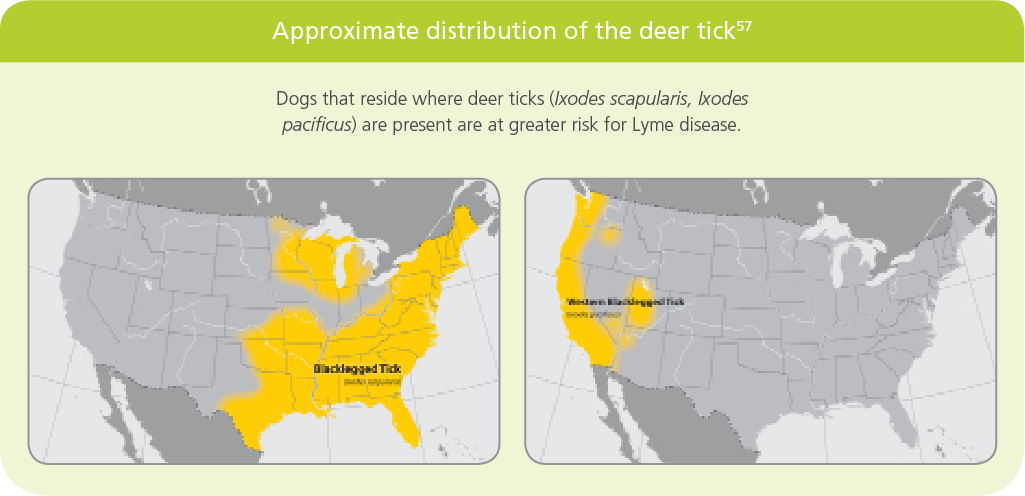Canine Lyme Disease
There’s an increase in ticks, and tick-related diseases, with the number of reported tickborne diseases more than doubling in the last 13 years.81
Product Description
NOBIVAC® LYME
Two inactivated isolates of Borrelia burgdorferi initiate the production of borreliacidal antibodies against OspA and OspC1, 5, 80. Shown to be effective against Borrelia burgdorferi and subclinical arthritis caused by Borrelia burgdorferi.
Disease Overview
Lyme disease is a bacterial infection transmitted by ticks to dogs, as well as to other animals and people.
Most Lyme disease in the United States is spread by the deer tick, which is found primarily in the Northeast, Southeast, and upper Midwest. The western black-legged tick is the primary cause of Lyme disease transmission in the western states (map pictured below).
LYME DISEASE FAST FACTS
- Ticks that can transmit Lyme disease have expanded their geographic range and are now being found in places they weren’t seen 20 years ago82
- Counties with high risk for Lyme increased 320% since the 1990s82
- CAPC data shows Nationwide, dogs are being exposed to Lyme disease outside of traditionally endemic areas54
- Approximately 75% of unvaccinated dogs in endemic areas will eventually test positive for Lyme disease55
- The best way to protect dogs is year-round flea and tick control and vaccinating those dogs that visit or live in endemic areas56


TRANSMISSION
Lyme disease is transmitted to through the bite of a tick that is carrying the bacterial spirochete, Borrelia burgdorferi. When the tick bites the dog and takes a blood meal, the blood causes the Borrelia to change its outer surface protein (Osp) from OpsA to OspC which allows it to move from the tick’s midgut into the dog’s blood stream. Once in the bloodstream, the Lyme disease organism is carried to many parts of the body and is likely to localize in joints.
CLINICAL SIGNS
- Arthritis
- Lameness
- Fever
- Anorexia
- Fatigue
DOGS AT RISK
- Lyme disease was traditionally thought to be limited primarily to the Northeastern region of the U.S. where deer populations were most dense. However, with the warming weather and the spread of the tick populations, Lyme disease is now prevalent in the majority of the U.S., increasing dogs at risk.
- Geography is no longer a rule out for Lyme risk with many people traveling with their dogs. Positive cases of canine Lyme disease have been reported across the U.S., with 39 states now reporting high and moderately high prevalence of canine Lyme disease.83
- Dogs at increased risk for Lyme disease include:
- Active dogs that walk or hike in the woods
- Dogs that play in fields
- Dogs that spend time in the yard
MORBIDITY THREATS
- Most commonly, dogs may present with fever, shifting leg lameness, swollen joints, enlarged lymph nodes, lethargy, depression and anorexia.
- Less commonly, dogs will develop a protein losing nephropathy that can result in hypoalbuminemia, edema and eventually renal failure, which is known as Lyme nephritis.
SPREADING DISEASE
- Infection occurs 24-48 hours after attaching to a host. B. burgdorferi is passed through the salivary glands of an infected tick into the animal.
- Once the animal is infected with spirochetes from the tick, the spirochetes spread through connective tissue and may result in infections in the joints, heart, and neural tissue.78
DIAGNOSIS
Diagnosis is based on history, clinical signs, elimination of other diagnoses, laboratory data, epidemiologic considerations, and response to antibiotic therapy. Mixed infections should be considered when clinical signs are apparent.
Long incubation periods, persistence of antibodies for months to years, and the disassociation of the antibody response from the clinical stage of disease make diagnosis by blood testing alone impossible.
Merck Animal Health Vaccines
Professional Resources and Educational Materials
Keep your clinic and staff informed and aware of diseases and outbreaks.
View More Nobivac ResourcesBrochure
Lyme Disease Pet Parent Guide
Printable brochure to educate pet parents about their dog’s risk for Canine Lyme Disease. What is Lyme disease? What are the signs of Lyme disease? How serious is Lyme disease?
TECHNICAL ASSISTANCE
For technical assistance or to report a suspected adverse drug reaction, contact Merck Animal Health at: 1-800-224-5318
References




 Go To United States
Go To United States Algeria
Algeria Argentina
Argentina Australia
Australia Austria
Austria Bahrain
Bahrain Belgium (Dutch)
Belgium (Dutch) Brazil
Brazil Canada (English)
Canada (English) Chile
Chile Colombia
Colombia Croatia
Croatia Czech Republic
Czech Republic Denmark
Denmark Ecuador
Ecuador Egypt
Egypt Finland
Finland France
France Germany
Germany Greece
Greece Hungary
Hungary India
India Indonesia
Indonesia Iraq
Iraq Ireland
Ireland Israel
Israel Italy
Italy Japan
Japan Jordan
Jordan Kuwait
Kuwait Lebanon
Lebanon Malaysia
Malaysia Mexico
Mexico Morocco
Morocco Netherlands
Netherlands New Zealand
New Zealand Norway
Norway Oman
Oman Panama
Panama Peru
Peru Philippines
Philippines Poland
Poland Portugal
Portugal Qatar
Qatar Romania
Romania Russian Federation
Russian Federation Saudi Arabia
Saudi Arabia South Africa
South Africa South Korea
South Korea Spain
Spain Sweden
Sweden Switzerland (French)
Switzerland (French) Taiwan
Taiwan Thailand
Thailand Tunisia
Tunisia Turkey
Turkey Ukraine
Ukraine United Arab Emirates
United Arab Emirates United Kingdom
United Kingdom Uruguay
Uruguay Yemen
Yemen Global
Global